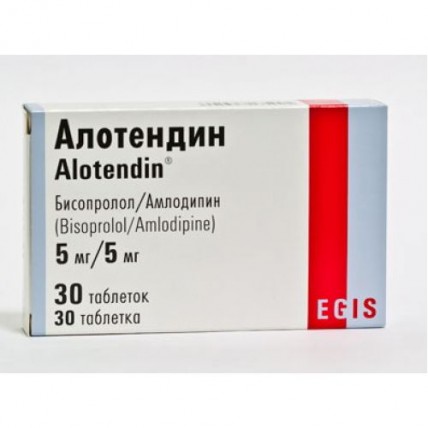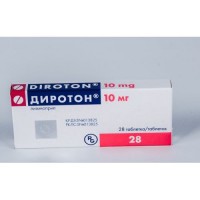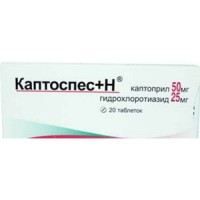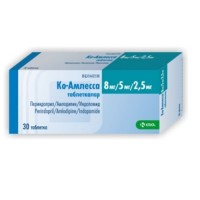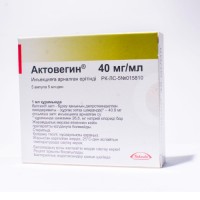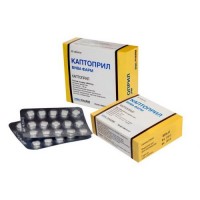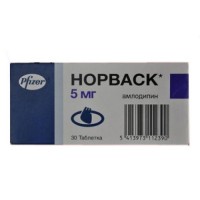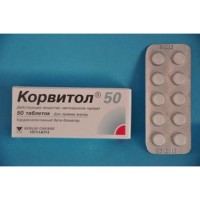The instruction for medical
use
of ALOTENDIN medicine
the Trade name
Alotendin
Mezhdunarodnoye the unlicensed name
Is not present
the Dosage form
of the Tablet, 5 mg / 5 mg, 10 mg / 5 mg, 5 mg / 10 mg, 10 mg / 10 mg
Structure
Structure
One tablet of 5 mg / 5 mg contains
active agent - the bisoprolola fumarates 5 mg
amlodipin 5 mg (in the form of 6.95 mg of an amlodipin of the besilat),
One tablet of 10 mg / 5мг contains
active agent - the bisoprolola fumarates 10 mg
amlodipin 5 mg (in the form of 6.95 mg of an amlodipin of the besilat),
One tablet 5mg/10 of mg contains
active agent - the bisoprolola fumarates 5 mg
amlodipin 10 mg (in the form of 13.9 mg of an amlodipin of the besilat),
One tablet of 10 mg / 10 mg contains
active agent - the bisoprolola fumarates 10 mg
amlodipin 10 mg (in the form of 13.9 mg of an amlodipin of the besilat),
excipients: cellulose microcrystalline sodium of starch glikolit (type A), magnesium stearate, silicon dioxide colloidal anhydrous
the Description
of the Tablet of 5/5 mg: white or flavourless almost white oblong slightly biconvex tablets, with risky on one party and with the engraving consisting of the stylized letter E and number 571 on other party of a tablet.
Tablets 5/10mg: white or flavourless almost white oval slightly biconvex tablets, from a tablet, risky on one party, and with the engraving consisting of the stylized letter E and number 572 on other party of a tablet.
Tablets of 10/5 mg: tablets, white or almost white round flat with a facet, flavourless, from a tablet, risky on one party, and with an engraving of the stylized letter E and number 573 on other party of a tablet.
Tablets of 10/10 mg: white or almost white round slightly biconvex tablets, flavourless, with risky on one party and with an engraving of the stylized letter E and number 574 on other party of a tablet.
Pharmacotherapeutic group
Beta blockers selection in a combination with other antihypertensives.
The code of automatic telephone exchange C07FB
the Pharmacological
Pharmacokinetics Later properties of intake amlodipin is well soaked up and peak values in blood are reached in 6-12 hours after reception. Meal does not affect its bioavailability. The absolute bioavailability is 64-80%. The volume of distribution is 21 l/kg. Equilibrium concentration in blood plasma (5-15 ng/ml) is reached in 7-8 days of daily dosing. The researches in vitro showed that 93-98% of the amlodipin circulating in a blood-groove contact proteins of blood plasma. Amlodipin is quickly metabolized (approximately for 90%) by a liver to inactive pyridinic derivatives. 10% of parent connection and 60% of inactive metabolites are excreted with urine, 20-25% – with a stake. Decrease in concentration in blood plasma has two-phase character. Final eliminative plasma elimination half-life of blood makes about 35-50 hours, and corresponds to dosing, single in day. The general clearance is equal to 7 ml/min. (weighing patient of 60 kg - 25 l/hour). At elderly patients this value is 19 l/hour.
The pharmacokinetics of an amlodipin does not undergo significant changes in a renal failure and with increase in age of patients.
In case of a liver failure – because of reduction of clearance – reduction of an initial dose is recommended.
Bisoprolol almost completely (> 90%) is soaked up from digestive tract. Owing to very small effect of the first passing through a liver (about 10%), the absolute bioavailability of drug after oral administration is about 90%. The volume of distribution is equal to 3.5 l/kg. Linking of a bisoprolol with proteins of blood plasma of 30%. Bisoprolol is excreted from an organism in two ways: 50% are metabolized by a liver to inactive metabolites which then are allocated with kidneys. The remained 50% are excreted by kidneys in invariable a look. As elimination happens in kidneys and a liver equally, correction of a dosage with easy and average degree of an abnormal liver function and kidneys is not required from patients. The general clearance is about 15 l/h. Eliminative plasma elimination half-life about 10 hours. The kinetics of a bisoprolol linear also does not depend on age.
A pharmacodynamics
Alotendin - the combined antihypertensive drug which part are a blocker of slow calcium channels (amlodipin) and selection β-adrenoblocker (bisoprolol). Drug has antihypertensive effect.
Amlodipin inhibits transmembrane transition of calcium ions to myocardial and smooth vascular muscle cells (a blocker of slow calcium channels or the antagonist of calcium ions). The mechanism of antihypertensive action is connected with the direct relaxing effect on smooth muscles of vessels that leads to decrease in peripheric vascular resistance.
The exact mechanism by means of which stenocardia symptoms are facilitated completely is not installed, and can include:
1) expansion of peripheral arterioles, thus, reduction of the general peripheric resistance (afterload). As it does not lead to reflex tachycardia, energy expenses a myocardium and oxygen requirement decrease.
2) due to expansion of the main coronal arteries and arterioles as in normal, and ischemic areas, there is an oxygen supply improvement. At the expense of it supply of oxygen to a myocardium, even in case of a spasm of coronal arteries (alternative stenocardia or Prinsmetal's stenocardia) increases.
At patients with arterial hypertension, single dose of drug for day provides clinically significant lowering of arterial pressure, as in a dorsal decubitus, and standing. Thanks to the slow beginning of action, sudden arterial hypotension is not characteristic.
At patients with stenocardia, at single dose in day the general time of tolerance to physical activities, time increases up ment of an attack of stenocardia and time to a significant depression of a segment of ST and also the frequency of attacks of stenocardia and quantity of the consumed glyceryl trinitrate tablets decreases. It was not connected with undesirable metabolic effects: drug did not affect the level of lipids in blood plasma, sugar level in blood and uric acid in blood serum, and was useful at patients with bronchial asthma.
Bisoprolol is powerful, high-selection β1-адренорено-блокатором, deprived of internal sympathomimetic activity (ISA) and also he has no essential membrane stabilizing properties.
He has low affinity to β2-рецепторам unstriated muscles of bronchial tubes and vessels and also to β2-рецепторам, concerning metabolic regulation. For this reason, it is improbable that bisoprolol in general influences a rezistetnost of airways and β2-опосредованные metabolic effects. β1-избирательность extends out of limits of range of therapeutic dosages. Bisoprolol has no distinct negative inotropic effect. The maximum effect of a bisoprolol develops in 3-4 hours after its oral appointment. Eliminative plasma elimination half-life (10-12 hours) provides 24-hour efficiency after drug dosing, single in day. Usually, the maximum antihypertensive effect develops in 2 weeks. At intense appointment at patients with coronary pathology of heart without chronic heart failure bisoprolol reduces the heart rate and stroke output and, thus, minute volume of heart and consumption of oxygen. At long appointment originally increased peripheric resistance decreases. The antihypertensive effect of β-blockers, besides others, is connected with renin decrease of the activity. Bisoprolol inhibits the response to simpatoadrenergichesky activation due to blockade of β-receptors in heart. It leads to decrease in heart rate and suppression of sokratitelny ability of a myocardium that leads to reduction of need of a cardiac muscle for oxygen.
Indications
- arterial hypertension in the form of monotherapy or if it is necessary, as a part of combination therapy with other antihypertensive drugs
- chronic stable stenocardia in the form of monotherapy or if it is necessary, as a part of combination therapy with other anti-anginal means
- as replacement therapy at patients, arterial blood pressure and/or chronic stable stenocardia at whom can adequately be controlled by simultaneous use of an amlodipin and bisoprolol in the same doses
, the Route of administration and doses
use Drug strictly on doctor's orders!
Alotendin is shown to patients at whom the increased arterial blood pressure or pathology of coronary vessels can adequately be controlled by separate prescribing of monocomponent drugs in the same doses, as in the recommended fixed combinations.
The recommended daily dose - 1 tablet of a certain dosage. Alotendin is recommended to accept in the morning, irrespective of meal, without chewing. Treatment should not be stopped suddenly as it can lead to temporary deterioration in a clinical state. Especially treatment should not be stopped sharply at the patients having coronary heart disease. The gradual dose decline is recommended.
In case of a liver failure, elimination of an amlodipin can drag on. There are no exact recommendations about dosing concerning an amlodipin therefore drug at these patients has to be appointed with care. In case of a heavy liver failure the daily dose of a bisoprolol should not exceed 10 mg.
With easy and average degree of a renal failure the change of a dosage is not required from patients. In case of a heavy renal failure (clearance of creatinine less than 20 ml/min.), the daily dose of a bisoprolol should not exceed 10 mg.
To elderly patients usual doses of drug can be appointed.
Side effects
Often (³1/100 -
- heartbeat, bradycardia
- a headache, dizziness, drowsiness, fatigue
- nausea, vomiting, diarrhea, a constipation, an abdominal pain
- "inflows"
- hypostases, peripheral hypostases
- feeling of a cold snap and numbness of extremities
Infrequently (³1/1,000 -
- a leukopenia, thrombocytopenia, a purpura
- visual disturbances, sleep disorders, a depression
- peripheral neuropathy, sinkope, a hypesthesia, paresthesias, a food faddism, a tremor
- arterial hypotension, disturbances of AV-conductivity, deterioration in the available heart failure
- short wind, cough, rhinitis, bronchial asthma or a bronchospasm with an obstructive disease of lungs in the anamnesis
- a pollakiuria, urination disorder, a nocturia
- arthralgias, myalgias, spasms in muscles, a dorsodynia, muscle weakness, spasms
- dryness in a mouth, a hyperplasia of gums, dyspepsia, pancreatitis
- the increased perspiration, an allopecia, decolouration of skin
- a hyperglycemia
- a vasculitis
- exhaustion, an asthenia, increase or weight reduction of a body
- disturbance of potency, a gynecomastia
- changes of mood
is rare (³1/10,000 -
- allergic skin reactions, an itching, rash, Quincke's disease, a mnogoformny exudative erythema
- reactions of hypersensitivity, such as itching, inflows, rash
- arterial hypotension
- decrease in secretion of plaintive liquid (it should be considered if the patient carries contact lenses)
- a hearing disorder, dreadful dreams, hallucinations
- increase in level of triglycerides
- allergic rhinitis
- increase in level of enzymes of a liver (AlAT, AsAT), hepatitis
- disturbance of potency
is Very rare (unknown (the assessment on the basis of the available data cannot be carried out)
- urticaria
- gastritis
- increase in level of enzymes of a liver
- a cholestasia, jaundice, hepatitis *
Is very rare (
-conjunctivitis
- an allopecia
- β-blockers can provoke or make heavier a psoriasis course, or can cause psoriazopodobny changes on skin
Mental disturbances
As well as in a case with other antagonists of calcium, such undesirable effects were reported (a myocardial infarction, arrhythmia / for example, ventricular tachycardia and an atrial fibrillation / and stenocardia) on the basis of which to solve whether are connected they with a basic disease or not – it is impossible.
* These symptoms are especially typical in an initiation of treatment. In general they are expressed slightly and most often disappear within 1-2 weeks.
Contraindications
- hypersensitivity to an amlodipin, dihydropyridine derivatives, a bisoprolol and/or any of excipients
- unstable stenocardia
- the profound stenosis of an aorta
- the acute heart failure or episodes of heart failure demanding intravenous administration of drugs with inotropic action
- cardiogenic shock
- AV-blockade of II or III degree (without pacemaker)
- a sick sinus syndrome
- sinuatrial blockade
- bradycardia (heart rate less than 60 blows/min.) before an initiation of treatment
- arterial hypotension (systolic arterial blood pressure
- heavy bronchial asthma or a serious chronic obstructive illness of lungs
- late stages of okklyuziruyushchy diseases of peripheral arteries and a severe form of a syndrome of Reynaud
- not treated pheochromocytoma
- a metabolic acidosis
- feeding by a breast
Medicinal interactions
Medicinal interactions are not completely known.
It is necessary to be careful at combined use of drug with thiazide diuretics, β-blockers, nitrates of long action, sublingual drugs of trinitrate of glyceryl, non-steroidal anti-inflammatory drugs, antibiotics, oral hypoglycemic drugs.
Joint appointment of Alotendin with digoxin did not lead to change of levels of digoxin in blood serum and did not affect renal clearance of digoxin.
Joint prescribing of drug with Cimetidinum did not influence pharmacokinetics of an amlodipin.
Amlodipin does not influence linking of digoxin, Phenytoinum, coumarin and indometacin with proteins of blood plasma.
Joint appointment of Alotendin and warfarin did not cause significant effect on a prothrombin time.
Consumption of grapefruit juice can lead to some increase in serumal levels of an amlodipin, but does not give clinically significant changes of arterial blood pressure.
Not recommended combinations:
- antagonists of calcium of type of verapamil and, to a lesser extent, like diltiazem negatively affect sokratitelny ability, atrioventricular carrying out and arterial blood pressure. Intravenous administration of verapamil at the patients receiving treatment by β-blockers can lead to the profound arterial hypotension and atrioventricular block,
- simultaneous use with antihypertensive drugs of the central action (for example, a clonidine, Methyldopum, moksonodin, rilmenidin) can lead to an urezheniye of ChSS, minute volume of heart and a vazodilatation. Sharp drug withdrawal can cause the increased risk of "a withdrawal in the form of hypertensia".
Alotendin's combinations with the following drugs have to be used with extra care:
- antagonists of calcium of type of dihydropyridine, such as nifedipine, can increase risk of arterial hypotension, and at patients with heart failure it is impossible to exclude risk of strengthening of further deterioration in pump function of ventricles,
- antiarrhytmic drugs I of a class (for example, Disopyramidum, quinidine, lidocaine, Phenytoinum, flekainid, propafenon) can exponentiate effect for the period of atrioventricular carrying out and strengthening of negative inotropic effect is possible,
- antiarrhytmic drugs III of a class (for example, Amiodaronum) can exponentiate effect for the period of atrioventricular carrying out,
- parasympathomimetic means can cause increase in time of atrioventricular carrying out and, thus, increase risk of developing bradycardia,
- the topical drugs containing a β-blocker (for example, eye drops for treatment of glaucoma) can change system effects of drug,
- insulin and oral antidiabetic drugs can cause strengthening of hypoglycemic effect. Blockade of β-adrenoceptors can mask hypoglycemia symptoms,
- glycosides of a foxglove can cause urezheny ChSS, increase in time of atrioventricular carrying out,
- non-steroidal anti-inflammatory drugs (NPVS) can reduce hypotensive effect of drug,
- β-sympathomimetic means (for example, izoprenalin, Dobutaminum) can reduce effect of both drugs,
- antihypertensive drugs and also other means, having hypotensive effect (for example, tricyclic antidepressants, barbiturates, fenotiazina) can increase risk of arterial hypotension.
At patients to whom the general anesthesia was carried out the β-blockade reduced the frequency of arrhythmia and ischemia of a myocardium during induction of anesthesia and an intubation and also in the postoperative period. Now it is recommended that maintenance of β-blockade was provided perioperatsionno. The anesthesiologist should remember β-blockade because of interaction potentiality with other drugs that can cause bradyarrhythmia, easing of reflex tachycardia and oppression of a reflex opportunity to compensate blood loss. If it is necessary to cancel reception of a β-blocker before surgical intervention, it has to be executed gradually, and is complete approximately within 48 hours to anesthesia.
Alotendin's combinations with drugs demanding consideration:
- meflokin can increase risk of bradycardia,
- monoaminooxidase inhibitors (except for MAO-B inhibitors): can enhance hypotensive effect of β-blockers and also increase risk of hypertensive crisis.
Special instructions
with heart failure of II/III of a class on NYHA Alotendin did not cause deterioration in a clinical state concerning shipping of physical activities, changes of fraction of emission of a left ventricle and clinical symptoms In patients.
Patients with heart failure have class III/IV on NYHA, applying APF inhibitors, diuretics and digoxin, Alotendin's addition to the scheme of treatment did not cause growth of frequency of cardiovascular pathology or cardiovascular mortality.
As the vazodilatation induced by Alotendin's reception is characterized by the gradual beginning, was reported about cases of sharply developing arterial hypotension seldom.
Especially in case of coronary heart disease, treatment should not be stopped suddenly if there are only no accurate indications to drug withdrawal as it can lead to temporary deterioration in cardial pathology.
Alotendin has to be appointed with extra care to patients with arterial hypertension or stenocardia, connected with heart failure.
Drug has to be used with care at the following states:
- diabetes with big fluctuations of level of glucose of blood, symptoms of a hypoglycemia can mask,
- strict starvation / diet,
- at the same time carried out desensibilizing therapy (As well as in case of reception of other β-blockers, drug can cause increase in sensitivity to allergens and weighting of anaphylactic reactions. Adrenaline use can not always give the expected therapeutic effect),
- AV-blockade of the I degree,
- Prinsmetal's stenocardia,
- occlusal diseases of peripheral arteries (strengthening of complaints can be especially expressed in an initiation of treatment),
- psoriasis or its existence in the anamnesis – in this case have to be used only β-blockers (bisoprolol) after thorough examination of advantage and risks,
- at treatment by Alotendin, symptoms of a hyperthyroidism can be erased,
- to patients with a pheochromocytoma Alotendin has to be appointed only after blockade of α-receptors,
- before carrying out the general anesthesia the anesthesiologist has to obtain information on reception by the patient of β-blockers. If it is necessary to cancel a β-blocker before surgical intervention, it has to be executed gradually, and is complete approximately within 48 hours to anesthesia,
- in bronchial asthma and other chronic obstructive diseases of lungs which can cause symptoms, bronkhodilatiruyushchy therapy at the same time has to be carried out. In some cases at patients with bronchial asthma the increase in resistance in airways can develop, and for this reason the increase in a dose β2-стимуляторов can be required.
Alotendin is not recommended to apply use in pediatrics for children and teenagers 18 years due to the lack of data on safety and efficiency of use in this category of patients are younger.
Pregnancy and feeding by a breast
In toxicity tests on Amlodipin's influence on reproductive function, any effect on fertility or the general reproductive ability is noted. Like other β-blockers, concerning a bisoprolol the maternal toxicity and embryonal / neonatal toxicity was shown, but teratogenic action was not observed.
Due to the lack of sufficient clinical experience on use of drug during pregnancy and a lactation, in case of pregnancy or in a case the solution of a question of therapy at the women with a genital potential who are not applying effective methods of contraception, Amlodipin can be appointed only according to very strict indications after thorough examination of a ratio risk/advantage. For lack of other alternatives, in case of therapy by Alotendin, the termination of a lactation is recommended. Bisoprolol renders pharmacological effects which can cause harmful effects on pregnancy and/or the fruit/newborn. In general, β-adrenoblockers reduce placentary perfusion that causes a growth inhibition, intrauterine death, a misbirth and early childbirth. At a fruit and the newborn undesirable effects (hypoglycemia and bradycardia) can be observed. If treatment by β-adrenoblockers is necessary, are preferable selection β1-адреноблокаторы.
Alotendin it is not necessary to apply during pregnancy if only to that there are no strict indications. If treatment by Alotendin is considered necessary, careful monitoring of an uteroplacental blood-groove and growth of a fruit is required. In case of negative impact on pregnancy or a fruit, it is necessary to resolve an issue of alternative treatment. Newborns have to be observed carefully. Symptoms of a hypoglycemia and bradycardia in general are expected during the first 3 days. There are no data on excretion of drug in breast milk therefore Alotendin's appointment when feeding by a breast is not recommended.
Features of influence of medicine on ability to run the vehicle or potentially dangerous mechanisms.
On the basis of clinical experience, it is possible to assume lack of influence on the specified abilities. Nevertheless, considering variability of individual reactions to drug, the ability to run vehicles and mechanisms can be broken. Such influence is most often noted in an initiation of treatment, at change of treatment and in case of simultaneous alcohol intake.
Overdose
Symptoms: bradycardia, arterial hypotension, bronchospasm, acute heart failure and hypoglycemia. There is a broad interpersonal variability in sensitivity and in reaction to a single high dose of a bisoprolol: patients with pathology of heart are perhaps more sensitive to effects of a bisoprolol. At massive overdose the excess peripheral vazodilatation with the profound and persistent arterial hypotension and, perhaps, reflex tachycardia is possible. There are data on very exceptional cases of deliberate overdose.
Treatment: At overdose, drug has to be cancelled, and the supporting and symptomatic treatment is begun. In view of slow absorption of drug, gastric lavage. In case of clinically significant arterial hypotension, active cardiovascular support, monitoring of action of the heart and breath, raising of the lower extremities, control of volume of the circulating liquid and a diuresis and also intensive maintenance therapy is necessary. Use of vasoconstrictors can be useful in restoration of a vascular tone and arterial blood pressure provided that there are no contraindications to their use. Intravenous administration of calcium of a gluconate can promote regress of effects of blockade of calcium channels. In bradycardia: intravenous administration of atropine. If the answer is insufficient, with care can be appointed izoprenalin or other drugs with positive chronotropic action. In certain cases transvenous installation of an artificial pacemaker can be required. In arterial hypotension: intravenous infusions and vazopressor, intravenous administration of a glucagon. At AV-blockade (II or III degree): carefully observation of a condition of the patient, infusion of an izoprenalin or can be required implantation of an artificial pacemaker. At sudden deterioration in heart failure: intravenous administration of diuretics, drugs with positive inotropic action, vazodilatator. At a bronchospasm: use of bronchodilators (for example, izoprenalin, β2-симпатомиметики and/or Aminophyllinum). At a hypoglycemia: intravenous administration of glucose. As drug has high extent of linking with proteins of blood plasma, dialysis will not give notable advantage.
Form of release and packing
of the Tablet of 5 mg / 5 mg, 10 mg / 5 mg, 5 mg / 10 mg, 10 mg / 10 mg. On 7 or 10 tablets in the blister strip packagings consisting of the combined film of "cold" (polyamide / aluminum foil / PVC) / aluminum foil. On 3 and 9 blister strip packagings on 10 tablets, and on 4 and 8 blister strip packagings on 7 tablets together with the instruction for medical use in the state and Russian languages place in a pack from cardboard.
3 years
not to use a period of storage after an expiration date.
To Store storage conditions at a temperature not above 25 °C.
To store out of children's reach!
Prescription status
According to the prescription
BUDAPEST JSC EGIS PHARMATSEVTICHESKY PLANT Producer 1106, st. Keresturi, 30-38 Hungary
Phone number: (36-1) 803-5555, fax: (36-1) 803-5529
Address of the organization accepting in the territory of the Republic of Kazakhstan claims from consumers on quality of products (goods)
Representation in RK JSC Pharmatsevtichesky
the EGIS 050060 plant, Almaty, Zharokov St. of 286 G
ph. + 7 (727) 299 80 29, + 7 (727) 299 80 22, fax: + 7 (727) 299 79 95,
e-mail:
egis@egis.kz
use
of ALOTENDIN medicine
the Trade name
Alotendin
Mezhdunarodnoye the unlicensed name
Is not present
the Dosage form
of the Tablet, 5 mg / 5 mg, 10 mg / 5 mg, 5 mg / 10 mg, 10 mg / 10 mg
Structure
Structure
One tablet of 5 mg / 5 mg contains
active agent - the bisoprolola fumarates 5 mg
amlodipin 5 mg (in the form of 6.95 mg of an amlodipin of the besilat),
One tablet of 10 mg / 5мг contains
active agent - the bisoprolola fumarates 10 mg
amlodipin 5 mg (in the form of 6.95 mg of an amlodipin of the besilat),
One tablet 5mg/10 of mg contains
active agent - the bisoprolola fumarates 5 mg
amlodipin 10 mg (in the form of 13.9 mg of an amlodipin of the besilat),
One tablet of 10 mg / 10 mg contains
active agent - the bisoprolola fumarates 10 mg
amlodipin 10 mg (in the form of 13.9 mg of an amlodipin of the besilat),
excipients: cellulose microcrystalline sodium of starch glikolit (type A), magnesium stearate, silicon dioxide colloidal anhydrous
the Description
of the Tablet of 5/5 mg: white or flavourless almost white oblong slightly biconvex tablets, with risky on one party and with the engraving consisting of the stylized letter E and number 571 on other party of a tablet.
Tablets 5/10mg: white or flavourless almost white oval slightly biconvex tablets, from a tablet, risky on one party, and with the engraving consisting of the stylized letter E and number 572 on other party of a tablet.
Tablets of 10/5 mg: tablets, white or almost white round flat with a facet, flavourless, from a tablet, risky on one party, and with an engraving of the stylized letter E and number 573 on other party of a tablet.
Tablets of 10/10 mg: white or almost white round slightly biconvex tablets, flavourless, with risky on one party and with an engraving of the stylized letter E and number 574 on other party of a tablet.
Pharmacotherapeutic group
Beta blockers selection in a combination with other antihypertensives.
The code of automatic telephone exchange C07FB
the Pharmacological
Pharmacokinetics Later properties of intake amlodipin is well soaked up and peak values in blood are reached in 6-12 hours after reception. Meal does not affect its bioavailability. The absolute bioavailability is 64-80%. The volume of distribution is 21 l/kg. Equilibrium concentration in blood plasma (5-15 ng/ml) is reached in 7-8 days of daily dosing. The researches in vitro showed that 93-98% of the amlodipin circulating in a blood-groove contact proteins of blood plasma. Amlodipin is quickly metabolized (approximately for 90%) by a liver to inactive pyridinic derivatives. 10% of parent connection and 60% of inactive metabolites are excreted with urine, 20-25% – with a stake. Decrease in concentration in blood plasma has two-phase character. Final eliminative plasma elimination half-life of blood makes about 35-50 hours, and corresponds to dosing, single in day. The general clearance is equal to 7 ml/min. (weighing patient of 60 kg - 25 l/hour). At elderly patients this value is 19 l/hour.
The pharmacokinetics of an amlodipin does not undergo significant changes in a renal failure and with increase in age of patients.
In case of a liver failure – because of reduction of clearance – reduction of an initial dose is recommended.
Bisoprolol almost completely (> 90%) is soaked up from digestive tract. Owing to very small effect of the first passing through a liver (about 10%), the absolute bioavailability of drug after oral administration is about 90%. The volume of distribution is equal to 3.5 l/kg. Linking of a bisoprolol with proteins of blood plasma of 30%. Bisoprolol is excreted from an organism in two ways: 50% are metabolized by a liver to inactive metabolites which then are allocated with kidneys. The remained 50% are excreted by kidneys in invariable a look. As elimination happens in kidneys and a liver equally, correction of a dosage with easy and average degree of an abnormal liver function and kidneys is not required from patients. The general clearance is about 15 l/h. Eliminative plasma elimination half-life about 10 hours. The kinetics of a bisoprolol linear also does not depend on age.
A pharmacodynamics
Alotendin - the combined antihypertensive drug which part are a blocker of slow calcium channels (amlodipin) and selection β-adrenoblocker (bisoprolol). Drug has antihypertensive effect.
Amlodipin inhibits transmembrane transition of calcium ions to myocardial and smooth vascular muscle cells (a blocker of slow calcium channels or the antagonist of calcium ions). The mechanism of antihypertensive action is connected with the direct relaxing effect on smooth muscles of vessels that leads to decrease in peripheric vascular resistance.
The exact mechanism by means of which stenocardia symptoms are facilitated completely is not installed, and can include:
1) expansion of peripheral arterioles, thus, reduction of the general peripheric resistance (afterload). As it does not lead to reflex tachycardia, energy expenses a myocardium and oxygen requirement decrease.
2) due to expansion of the main coronal arteries and arterioles as in normal, and ischemic areas, there is an oxygen supply improvement. At the expense of it supply of oxygen to a myocardium, even in case of a spasm of coronal arteries (alternative stenocardia or Prinsmetal's stenocardia) increases.
At patients with arterial hypertension, single dose of drug for day provides clinically significant lowering of arterial pressure, as in a dorsal decubitus, and standing. Thanks to the slow beginning of action, sudden arterial hypotension is not characteristic.
At patients with stenocardia, at single dose in day the general time of tolerance to physical activities, time increases up ment of an attack of stenocardia and time to a significant depression of a segment of ST and also the frequency of attacks of stenocardia and quantity of the consumed glyceryl trinitrate tablets decreases. It was not connected with undesirable metabolic effects: drug did not affect the level of lipids in blood plasma, sugar level in blood and uric acid in blood serum, and was useful at patients with bronchial asthma.
Bisoprolol is powerful, high-selection β1-адренорено-блокатором, deprived of internal sympathomimetic activity (ISA) and also he has no essential membrane stabilizing properties.
He has low affinity to β2-рецепторам unstriated muscles of bronchial tubes and vessels and also to β2-рецепторам, concerning metabolic regulation. For this reason, it is improbable that bisoprolol in general influences a rezistetnost of airways and β2-опосредованные metabolic effects. β1-избирательность extends out of limits of range of therapeutic dosages. Bisoprolol has no distinct negative inotropic effect. The maximum effect of a bisoprolol develops in 3-4 hours after its oral appointment. Eliminative plasma elimination half-life (10-12 hours) provides 24-hour efficiency after drug dosing, single in day. Usually, the maximum antihypertensive effect develops in 2 weeks. At intense appointment at patients with coronary pathology of heart without chronic heart failure bisoprolol reduces the heart rate and stroke output and, thus, minute volume of heart and consumption of oxygen. At long appointment originally increased peripheric resistance decreases. The antihypertensive effect of β-blockers, besides others, is connected with renin decrease of the activity. Bisoprolol inhibits the response to simpatoadrenergichesky activation due to blockade of β-receptors in heart. It leads to decrease in heart rate and suppression of sokratitelny ability of a myocardium that leads to reduction of need of a cardiac muscle for oxygen.
Indications
- arterial hypertension in the form of monotherapy or if it is necessary, as a part of combination therapy with other antihypertensive drugs
- chronic stable stenocardia in the form of monotherapy or if it is necessary, as a part of combination therapy with other anti-anginal means
- as replacement therapy at patients, arterial blood pressure and/or chronic stable stenocardia at whom can adequately be controlled by simultaneous use of an amlodipin and bisoprolol in the same doses
, the Route of administration and doses
use Drug strictly on doctor's orders!
Alotendin is shown to patients at whom the increased arterial blood pressure or pathology of coronary vessels can adequately be controlled by separate prescribing of monocomponent drugs in the same doses, as in the recommended fixed combinations.
The recommended daily dose - 1 tablet of a certain dosage. Alotendin is recommended to accept in the morning, irrespective of meal, without chewing. Treatment should not be stopped suddenly as it can lead to temporary deterioration in a clinical state. Especially treatment should not be stopped sharply at the patients having coronary heart disease. The gradual dose decline is recommended.
In case of a liver failure, elimination of an amlodipin can drag on. There are no exact recommendations about dosing concerning an amlodipin therefore drug at these patients has to be appointed with care. In case of a heavy liver failure the daily dose of a bisoprolol should not exceed 10 mg.
With easy and average degree of a renal failure the change of a dosage is not required from patients. In case of a heavy renal failure (clearance of creatinine less than 20 ml/min.), the daily dose of a bisoprolol should not exceed 10 mg.
To elderly patients usual doses of drug can be appointed.
Side effects
Often (³1/100 -
- heartbeat, bradycardia
- a headache, dizziness, drowsiness, fatigue
- nausea, vomiting, diarrhea, a constipation, an abdominal pain
- "inflows"
- hypostases, peripheral hypostases
- feeling of a cold snap and numbness of extremities
Infrequently (³1/1,000 -
- a leukopenia, thrombocytopenia, a purpura
- visual disturbances, sleep disorders, a depression
- peripheral neuropathy, sinkope, a hypesthesia, paresthesias, a food faddism, a tremor
- arterial hypotension, disturbances of AV-conductivity, deterioration in the available heart failure
- short wind, cough, rhinitis, bronchial asthma or a bronchospasm with an obstructive disease of lungs in the anamnesis
- a pollakiuria, urination disorder, a nocturia
- arthralgias, myalgias, spasms in muscles, a dorsodynia, muscle weakness, spasms
- dryness in a mouth, a hyperplasia of gums, dyspepsia, pancreatitis
- the increased perspiration, an allopecia, decolouration of skin
- a hyperglycemia
- a vasculitis
- exhaustion, an asthenia, increase or weight reduction of a body
- disturbance of potency, a gynecomastia
- changes of mood
is rare (³1/10,000 -
- allergic skin reactions, an itching, rash, Quincke's disease, a mnogoformny exudative erythema
- reactions of hypersensitivity, such as itching, inflows, rash
- arterial hypotension
- decrease in secretion of plaintive liquid (it should be considered if the patient carries contact lenses)
- a hearing disorder, dreadful dreams, hallucinations
- increase in level of triglycerides
- allergic rhinitis
- increase in level of enzymes of a liver (AlAT, AsAT), hepatitis
- disturbance of potency
is Very rare (unknown (the assessment on the basis of the available data cannot be carried out)
- urticaria
- gastritis
- increase in level of enzymes of a liver
- a cholestasia, jaundice, hepatitis *
Is very rare (
-conjunctivitis
- an allopecia
- β-blockers can provoke or make heavier a psoriasis course, or can cause psoriazopodobny changes on skin
Mental disturbances
As well as in a case with other antagonists of calcium, such undesirable effects were reported (a myocardial infarction, arrhythmia / for example, ventricular tachycardia and an atrial fibrillation / and stenocardia) on the basis of which to solve whether are connected they with a basic disease or not – it is impossible.
* These symptoms are especially typical in an initiation of treatment. In general they are expressed slightly and most often disappear within 1-2 weeks.
Contraindications
- hypersensitivity to an amlodipin, dihydropyridine derivatives, a bisoprolol and/or any of excipients
- unstable stenocardia
- the profound stenosis of an aorta
- the acute heart failure or episodes of heart failure demanding intravenous administration of drugs with inotropic action
- cardiogenic shock
- AV-blockade of II or III degree (without pacemaker)
- a sick sinus syndrome
- sinuatrial blockade
- bradycardia (heart rate less than 60 blows/min.) before an initiation of treatment
- arterial hypotension (systolic arterial blood pressure
- heavy bronchial asthma or a serious chronic obstructive illness of lungs
- late stages of okklyuziruyushchy diseases of peripheral arteries and a severe form of a syndrome of Reynaud
- not treated pheochromocytoma
- a metabolic acidosis
- feeding by a breast
Medicinal interactions
Medicinal interactions are not completely known.
It is necessary to be careful at combined use of drug with thiazide diuretics, β-blockers, nitrates of long action, sublingual drugs of trinitrate of glyceryl, non-steroidal anti-inflammatory drugs, antibiotics, oral hypoglycemic drugs.
Joint appointment of Alotendin with digoxin did not lead to change of levels of digoxin in blood serum and did not affect renal clearance of digoxin.
Joint prescribing of drug with Cimetidinum did not influence pharmacokinetics of an amlodipin.
Amlodipin does not influence linking of digoxin, Phenytoinum, coumarin and indometacin with proteins of blood plasma.
Joint appointment of Alotendin and warfarin did not cause significant effect on a prothrombin time.
Consumption of grapefruit juice can lead to some increase in serumal levels of an amlodipin, but does not give clinically significant changes of arterial blood pressure.
Not recommended combinations:
- antagonists of calcium of type of verapamil and, to a lesser extent, like diltiazem negatively affect sokratitelny ability, atrioventricular carrying out and arterial blood pressure. Intravenous administration of verapamil at the patients receiving treatment by β-blockers can lead to the profound arterial hypotension and atrioventricular block,
- simultaneous use with antihypertensive drugs of the central action (for example, a clonidine, Methyldopum, moksonodin, rilmenidin) can lead to an urezheniye of ChSS, minute volume of heart and a vazodilatation. Sharp drug withdrawal can cause the increased risk of "a withdrawal in the form of hypertensia".
Alotendin's combinations with the following drugs have to be used with extra care:
- antagonists of calcium of type of dihydropyridine, such as nifedipine, can increase risk of arterial hypotension, and at patients with heart failure it is impossible to exclude risk of strengthening of further deterioration in pump function of ventricles,
- antiarrhytmic drugs I of a class (for example, Disopyramidum, quinidine, lidocaine, Phenytoinum, flekainid, propafenon) can exponentiate effect for the period of atrioventricular carrying out and strengthening of negative inotropic effect is possible,
- antiarrhytmic drugs III of a class (for example, Amiodaronum) can exponentiate effect for the period of atrioventricular carrying out,
- parasympathomimetic means can cause increase in time of atrioventricular carrying out and, thus, increase risk of developing bradycardia,
- the topical drugs containing a β-blocker (for example, eye drops for treatment of glaucoma) can change system effects of drug,
- insulin and oral antidiabetic drugs can cause strengthening of hypoglycemic effect. Blockade of β-adrenoceptors can mask hypoglycemia symptoms,
- glycosides of a foxglove can cause urezheny ChSS, increase in time of atrioventricular carrying out,
- non-steroidal anti-inflammatory drugs (NPVS) can reduce hypotensive effect of drug,
- β-sympathomimetic means (for example, izoprenalin, Dobutaminum) can reduce effect of both drugs,
- antihypertensive drugs and also other means, having hypotensive effect (for example, tricyclic antidepressants, barbiturates, fenotiazina) can increase risk of arterial hypotension.
At patients to whom the general anesthesia was carried out the β-blockade reduced the frequency of arrhythmia and ischemia of a myocardium during induction of anesthesia and an intubation and also in the postoperative period. Now it is recommended that maintenance of β-blockade was provided perioperatsionno. The anesthesiologist should remember β-blockade because of interaction potentiality with other drugs that can cause bradyarrhythmia, easing of reflex tachycardia and oppression of a reflex opportunity to compensate blood loss. If it is necessary to cancel reception of a β-blocker before surgical intervention, it has to be executed gradually, and is complete approximately within 48 hours to anesthesia.
Alotendin's combinations with drugs demanding consideration:
- meflokin can increase risk of bradycardia,
- monoaminooxidase inhibitors (except for MAO-B inhibitors): can enhance hypotensive effect of β-blockers and also increase risk of hypertensive crisis.
Special instructions
with heart failure of II/III of a class on NYHA Alotendin did not cause deterioration in a clinical state concerning shipping of physical activities, changes of fraction of emission of a left ventricle and clinical symptoms In patients.
Patients with heart failure have class III/IV on NYHA, applying APF inhibitors, diuretics and digoxin, Alotendin's addition to the scheme of treatment did not cause growth of frequency of cardiovascular pathology or cardiovascular mortality.
As the vazodilatation induced by Alotendin's reception is characterized by the gradual beginning, was reported about cases of sharply developing arterial hypotension seldom.
Especially in case of coronary heart disease, treatment should not be stopped suddenly if there are only no accurate indications to drug withdrawal as it can lead to temporary deterioration in cardial pathology.
Alotendin has to be appointed with extra care to patients with arterial hypertension or stenocardia, connected with heart failure.
Drug has to be used with care at the following states:
- diabetes with big fluctuations of level of glucose of blood, symptoms of a hypoglycemia can mask,
- strict starvation / diet,
- at the same time carried out desensibilizing therapy (As well as in case of reception of other β-blockers, drug can cause increase in sensitivity to allergens and weighting of anaphylactic reactions. Adrenaline use can not always give the expected therapeutic effect),
- AV-blockade of the I degree,
- Prinsmetal's stenocardia,
- occlusal diseases of peripheral arteries (strengthening of complaints can be especially expressed in an initiation of treatment),
- psoriasis or its existence in the anamnesis – in this case have to be used only β-blockers (bisoprolol) after thorough examination of advantage and risks,
- at treatment by Alotendin, symptoms of a hyperthyroidism can be erased,
- to patients with a pheochromocytoma Alotendin has to be appointed only after blockade of α-receptors,
- before carrying out the general anesthesia the anesthesiologist has to obtain information on reception by the patient of β-blockers. If it is necessary to cancel a β-blocker before surgical intervention, it has to be executed gradually, and is complete approximately within 48 hours to anesthesia,
- in bronchial asthma and other chronic obstructive diseases of lungs which can cause symptoms, bronkhodilatiruyushchy therapy at the same time has to be carried out. In some cases at patients with bronchial asthma the increase in resistance in airways can develop, and for this reason the increase in a dose β2-стимуляторов can be required.
Alotendin is not recommended to apply use in pediatrics for children and teenagers 18 years due to the lack of data on safety and efficiency of use in this category of patients are younger.
Pregnancy and feeding by a breast
In toxicity tests on Amlodipin's influence on reproductive function, any effect on fertility or the general reproductive ability is noted. Like other β-blockers, concerning a bisoprolol the maternal toxicity and embryonal / neonatal toxicity was shown, but teratogenic action was not observed.
Due to the lack of sufficient clinical experience on use of drug during pregnancy and a lactation, in case of pregnancy or in a case the solution of a question of therapy at the women with a genital potential who are not applying effective methods of contraception, Amlodipin can be appointed only according to very strict indications after thorough examination of a ratio risk/advantage. For lack of other alternatives, in case of therapy by Alotendin, the termination of a lactation is recommended. Bisoprolol renders pharmacological effects which can cause harmful effects on pregnancy and/or the fruit/newborn. In general, β-adrenoblockers reduce placentary perfusion that causes a growth inhibition, intrauterine death, a misbirth and early childbirth. At a fruit and the newborn undesirable effects (hypoglycemia and bradycardia) can be observed. If treatment by β-adrenoblockers is necessary, are preferable selection β1-адреноблокаторы.
Alotendin it is not necessary to apply during pregnancy if only to that there are no strict indications. If treatment by Alotendin is considered necessary, careful monitoring of an uteroplacental blood-groove and growth of a fruit is required. In case of negative impact on pregnancy or a fruit, it is necessary to resolve an issue of alternative treatment. Newborns have to be observed carefully. Symptoms of a hypoglycemia and bradycardia in general are expected during the first 3 days. There are no data on excretion of drug in breast milk therefore Alotendin's appointment when feeding by a breast is not recommended.
Features of influence of medicine on ability to run the vehicle or potentially dangerous mechanisms.
On the basis of clinical experience, it is possible to assume lack of influence on the specified abilities. Nevertheless, considering variability of individual reactions to drug, the ability to run vehicles and mechanisms can be broken. Such influence is most often noted in an initiation of treatment, at change of treatment and in case of simultaneous alcohol intake.
Overdose
Symptoms: bradycardia, arterial hypotension, bronchospasm, acute heart failure and hypoglycemia. There is a broad interpersonal variability in sensitivity and in reaction to a single high dose of a bisoprolol: patients with pathology of heart are perhaps more sensitive to effects of a bisoprolol. At massive overdose the excess peripheral vazodilatation with the profound and persistent arterial hypotension and, perhaps, reflex tachycardia is possible. There are data on very exceptional cases of deliberate overdose.
Treatment: At overdose, drug has to be cancelled, and the supporting and symptomatic treatment is begun. In view of slow absorption of drug, gastric lavage. In case of clinically significant arterial hypotension, active cardiovascular support, monitoring of action of the heart and breath, raising of the lower extremities, control of volume of the circulating liquid and a diuresis and also intensive maintenance therapy is necessary. Use of vasoconstrictors can be useful in restoration of a vascular tone and arterial blood pressure provided that there are no contraindications to their use. Intravenous administration of calcium of a gluconate can promote regress of effects of blockade of calcium channels. In bradycardia: intravenous administration of atropine. If the answer is insufficient, with care can be appointed izoprenalin or other drugs with positive chronotropic action. In certain cases transvenous installation of an artificial pacemaker can be required. In arterial hypotension: intravenous infusions and vazopressor, intravenous administration of a glucagon. At AV-blockade (II or III degree): carefully observation of a condition of the patient, infusion of an izoprenalin or can be required implantation of an artificial pacemaker. At sudden deterioration in heart failure: intravenous administration of diuretics, drugs with positive inotropic action, vazodilatator. At a bronchospasm: use of bronchodilators (for example, izoprenalin, β2-симпатомиметики and/or Aminophyllinum). At a hypoglycemia: intravenous administration of glucose. As drug has high extent of linking with proteins of blood plasma, dialysis will not give notable advantage.
Form of release and packing
of the Tablet of 5 mg / 5 mg, 10 mg / 5 mg, 5 mg / 10 mg, 10 mg / 10 mg. On 7 or 10 tablets in the blister strip packagings consisting of the combined film of "cold" (polyamide / aluminum foil / PVC) / aluminum foil. On 3 and 9 blister strip packagings on 10 tablets, and on 4 and 8 blister strip packagings on 7 tablets together with the instruction for medical use in the state and Russian languages place in a pack from cardboard.
3 years
not to use a period of storage after an expiration date.
To Store storage conditions at a temperature not above 25 °C.
To store out of children's reach!
Prescription status
According to the prescription
BUDAPEST JSC EGIS PHARMATSEVTICHESKY PLANT Producer 1106, st. Keresturi, 30-38 Hungary
Phone number: (36-1) 803-5555, fax: (36-1) 803-5529
Address of the organization accepting in the territory of the Republic of Kazakhstan claims from consumers on quality of products (goods)
Representation in RK JSC Pharmatsevtichesky
the EGIS 050060 plant, Almaty, Zharokov St. of 286 G
ph. + 7 (727) 299 80 29, + 7 (727) 299 80 22, fax: + 7 (727) 299 79 95,
e-mail:
egis@egis.kz
